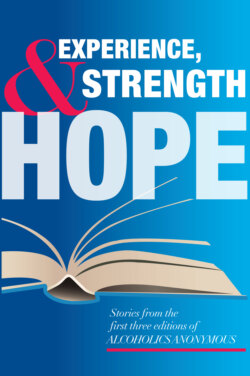Читать книгу Experience, Strength and Hope - Anonymous - Страница 8
На сайте Литреса книга снята с продажи.
ОглавлениеPART ONE
The stories presented here were deleted when the second edition of Alcoholics Anonymous was published, and the introductory material to this section provides information about A.A. as it was at that time.
It was 1955, and thanks largely to the Big Book, A.A.’s membership had grown from a few struggling groups with a total of about 100 members to an estimated 6,000 groups with more than 146,000 members. Traveling A.A.s and those serving in World War II had carried the message throughout the U.S. and Canada, and into about 50 other nations. The Twelve Traditions had been adopted in 1950, establishing guiding principles for the formation and development of groups everywhere. And at the 1955 Convention in St. Louis, A.A.’s “coming of age," the Three Legacies of Recovery, Unity, and Service were turned over to the Fellowship as a whole by its founding members.
Given all these changes, the 1939 Big Book’s personal stories section no longer adequately represented the membership, and co-founder Bill W. set out to broaden its scope in a revised edition. The Preface to the second edition explained: “When the book was first printed, we had scarcely 100 members all told, and every one of them was an almost hopeless case of alcoholism. This has changed. A.A. now helps alcoholics in all stages of the disease. It reaches into every level of life and into nearly all occupations. Our membership now includes many young people. Women, who were at first very reluctant to approach A.A., have come forward in large numbers. Therefore, the range of the story section has been broadened so that every alcoholic reader may find a reflection of him- or herself in it."
For the second edition, Bill restructured the story section in three parts: “Pioneers of A.A.," “They Stopped in Time," and “They Lost Nearly All." Only two stories from the first edition were retained intact; three were edited, one of which was retitled; two were completely rewritten, and 30 new stories were added. The completed section contained 38 stories, compared to 29 in the first edition (Dr. Bob’s, along with 28 others).
The stories that follow, reprinted from the first edition, take us back to the “trial and error" days, and paint a fascinating picture of what the A.A. experience was in the formative years. The A.A.s we meet here had been sober for very short periods of time (Bill W. was sober only three and a half years, Dr. Bob about three). They were still a little unsure and afraid of this “thing" they had found, still groping for clear guidelines, still largely uneducated about their alcoholism. Much of the terminology is strange to us: they wrote of “former alcoholics," described their recovery as a “cure," and referred to alcohol in terms such as “John Barleycorn." There were only a handful of groups at the time, and many of these writers found A.A. more or less by accident—perhaps a friend or relative happened to hear about a group of former drunks who were staying sober, or some early members heard about their problem and made a Twelfth Step call.
Some of the rough edges found in the first edition stories (the use of profanity, for example, references to specific religious beliefs, and several rather disorganized stories) would be smoothed out in those chosen for later editions. When Bill W. began the revision, he laid out some general guidelines: “Since the audience for the book is likely to be newcomers, anything from the point of view of content or style that might offend or alienate those who are not familiar with the program should be carefully eliminated. . . . Profanity, even when mild, rarely contributes as much as it detracts. It should be avoided." In a letter to a prospective contributor, Bill set forth the framework he was seeking: “We are looking for straight personal narratives which describe the drinking history, how the newcomer arrived in Alcoholics Anonymous, how A.A. affected him, and what A.A. has since accomplished for him."
But with all their faults of style, the differences between the stories we hear today and those written in 1939 are not important. These writers were alcoholics, and their experience rings true to any A.A. member of any time or place.
